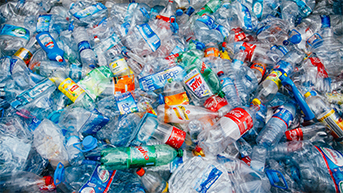This Sunday, April 22, is Earth Day, globally recognized as a day to take action in support of protecting the environment. The theme of this year’s Earth Day is End Plastic Pollution. According to the Earth Day Network, humans have generated the equivalent of 525,000,000 garbage trucks of plastic trash. Only 9 percent of the plastic produced has been recycled. If current production and waste management trends continue, 12 billion metric tons of plastic will enter landfills or the environment by 2050.

For commercial and multifamily real estate, the best response to the problem of plastic waste is to ensure that you have a comprehensive recycling program and that you have applied best practices to optimize its impact.
Let’s take a look at some of these best practices, which you can apply with the free tools available through the IREM Certified Sustainable Property (CSP) certification. After each best practice is a description of the CSP tools available.
Best Practice #1: Benchmark Waste
You can measure the effectiveness of a recycling program by benchmarking waste to determine the diversion rate—the amount of waste diverted from the landfill through recycling. According to the U.S. EPA, the national diversion rate is 34.6 percent, as of 2014.
EPA’s ENERGY STAR® Portfolio Manager® benchmarking tool has waste tracking capabilities, with the ability to track 29 types of materials handled in four different ways—recycled, composted, donated/reused and disposed. Waste haulers and recycling service providers may provide benchmarking services, using Portfolio Manager or another tool.
CSP Tool: A table to determine the property’s diversion rate, by assessing the volume of waste and recycling in bins over several days. To be as accurate as possible, consider drawing lines in the bins at different fill levels.
Best Practice #2: Educate Tenants and Residents
Property occupants must know what and how to recycle in order to maximize the diversion rate. You can help them by providing instructions periodically and installing signage next to or directly on bins. Make sure the instructions are clear and simple, preferably with images of recyclable materials. Your waste hauler or recycling service provider may provide signage.
CSP Tool: A customizable template to send a memo or email to occupants, with details about the property’s recycling program and how to participate.
Best Practice #3: Add Additional Recycling Programs
Besides standard recycling, consider the following programs:
- Construction waste recycling: Renovations, tenant improvements, and unit turnovers generate lots of waste. Establish a policy and procedures for recycling construction waste, and include clauses in service provider contracts requiring contractor teams to adhere to your practices.
- Bulk items, e-waste, battery and light bulb recycling: These items contain potentially hazardous materials and should be handled with care. You may have to engage a specialty recycling company to handle them. For e-waste, make sure that the company you choose follows the e-Stewards or R2 Standard. For bulk items such as old appliances, require the service provider to provide you with documentation that recycled items were handled responsibly and did not end up in landfills.
- Composting: Recycling of organic items such as food scrap and yard waste is becoming more common. In some markets, composting is even available for large office buildings. Ask your recycling service provider about composting services. Also check your local ordinances for any guidelines and prohibitions on composting programs.
- Vendor takeback programs: Suppliers and installers of carpeting, tile, roofing components, and other items often have takeback programs to recycle used materials.
- Donation drives: Toys for Tots, Goodwill, food drives, and other donation programs can improve the property’s overall diversion rate and extend your recycling program beyond the property by allowing staff and occupants to recycle items from home.
- Water recycling: Some municipalities, especially in drought-stricken areas, provide recycled water for landscaping and other functions where non-potable water is permissible. Private systems are available but may be cost-prohibitive for existing properties. Simple rain barrels are another option.
CSP Tools: Templates for policies and procedures on construction waste management and recycling of bulk items, e-waste, batteries, and light bulbs.

Best Practice #4: Focus on Continuous Improvement
Periodically assess the property’s recycling program and refresh your occupant outreach to maintain and improve the diversion rate. Ask the following questions:
- Are occupants complying with the recycling program?
- Do you have enough containers in the right places?
- Can you reduce the number of landfill waste containers and add more recycling bins, potentially cutting your overall waste management costs?
- Is a new program such as composting or yard waste recycling available in your area?
- Would a consultation with your recycling service provider or a waste management consultant help you meet your goals?
CSP Tools: A questionnaire to help you assess your recycling program; a checklist to help complete a container audit.
For more information and additional best practices on optimizing your property’s recycling program, visit EPA’s Reduce, Reuse, and Recycle pages.
About the Author
Todd Feist is the Sustainability Program Manager at IREM Headquarters in Chicago. He develops classroom and online courses and helps manage the IREM Sustainability program, including the IREM Certified Sustainable Property certification.